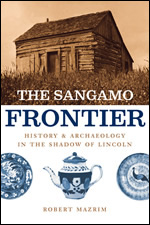The Sangamo Frontier
 The University of Chicago Press has just come out with Robert Mazrim's new book on antebellum central Illinois archeaology entitled, The Sangamo Frontier: History & Archaeology in the Shadow of Lincoln.
The University of Chicago Press has just come out with Robert Mazrim's new book on antebellum central Illinois archeaology entitled, The Sangamo Frontier: History & Archaeology in the Shadow of Lincoln.First off, I admit, I plugging the book because the publisher sent me not one, but two review copies in separate priority mail packages. I guess some how they knew that one was going to arrive damaged so they just sent a second to be sure I received one.
Actually, what's interesting is that I already bought the book last week. I can't really tell you right now how good is the book, but I have to give credit to Isaac Tobin who designed the book and cover.
Its strange color scheme and cover layout which is both tasteful but somewhat contrary to the normal rules of design works well. It grabbed my attention so I picked it up off the shelf.
As to the content, I have not started reading it from front to back yet. Instead, I've been flipping through the pages and checking out names I recognize from the index.
One of those names is Ninian Edwards, Illinois's territorial governor at the time he led militia troops into central Illinois during the War of 1812. The trail he followed became known as the Edwards Trace.
In my own research into the Old Slave House outside Equality, Illinois, Edwards shows up quite often. He owned the indentures of the Adams family whom John Crenshaw later kidnapped. Maria Adams served as the governor's cook and semptress. It was my interest in the current architectural research into the Old Slave House and next year's archaeological research already planned there that caused me to buy the book as it focuses on an Illinois community of the 1840s, the first decade Crenshaw lived in the house.
[Note to the editors, there's a typo in the index for Edwards. It lists info on him from pages 131-13. It should be 131-134.]
Most archaeology written about in Illinois seems to focus almost entirely on the prehistoric era, which is understandable. That's an era for which archaeologists don't compete with historians for the glory. Plus arrowheads have always attracted more interest than an early settler's refuse.
To study the archaeology of a 19th Century site also requires the skills of a historian. When both sides work together well the results can be impressive.
From what little I've seen so far Mazrim also displays possession of a third skill set. He's a writer and an engaging story teller, and that's something important when you're trying to make pottery shards interesting.
The titled settlement Sangamo Town itself is like New Salem, Illinois. It represents a frontier settlement that developed then disappeared all inside one generation. Unlike New Salem, Lincoln never lived there so no one thought to rebuild the settlement in the 20th Century.
I'll add more after I've read it, but for now I'd say it's a definite buy for anyone interested in the antebellum social history of Illinois.

3 Comments:
I've read nearly all of the book now and I can give it my own whole-hearted recommendation. It was one of the most thoughtful Christmas presents I've ever received.
Mazrim's work to date (which this book sums up) has contributed greatly to our understanding of the "Sangamo Country". Before the archeological evidence was unearthed, we really only had the recollections and reminiscences of the later 19th century to form a picture of frontier life here. Mazrim helps fill in the gaps with a hard look at the more prosaic aspects of frontier life that have gone missing all these years.
Especially interesting are Mazrim's discoveries of aboriginal gun flints that represent the very end of over 20,000 years of flintknapping culture in Illinois.
Mazrim operates his own museum in Elkhart showcasing hundreds of artifacts that go way beyond shards of broken teacups.
Disclosure: My Latham ancestors are prominently featured in the book, so I may be a little biased in my warmth for Mazrim and his work.
I am a direct desent of Asa Ledbeter who drowned in a flood near Shelbyville. Is there any info on him n this book?
I work for The History Press--a publishing company that focuses exclusively on publishing works of local and regional interest. We strive to preserve community stories that are too often overlooked by national and university presses.
We are in the midst of launching our Midwestern office and looking for writers and historians interested in working on a local history project.
Check out our website, www.historypress.net for more information or contact me at
allison.evans@historypress.net
Post a Comment
<< Home